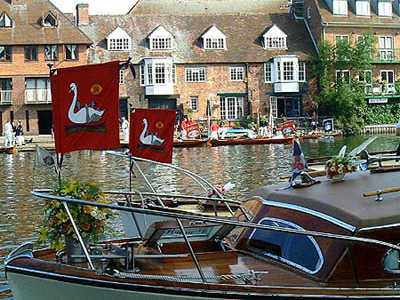
The Swan Upping
Fleet prepare to depart from
Eton College boathouses, 9.00am, 18th July 2000
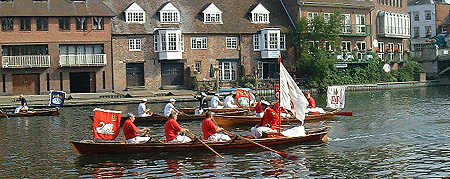 The Swan Uppers
set off from Windsor
The Swan Uppers
set off from Windsor
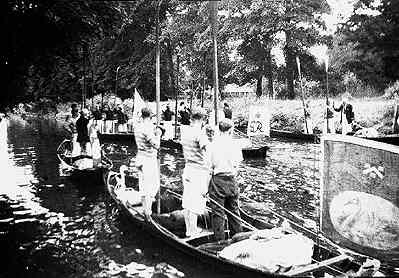
The flotilla of
Swan Uppers boats in Romney Lock Cut on the River Thames
at Windsor in the late 1940s. Note the flag featuring GR (centre
right) indicating that
George VI (George Rex) was king at the time.
The photograph
above records a ceremony associated with Swan Upping for many
years,
where the Vintners and Dyers Companies stand to drink a toast
to the Monarch
after passing through Romney Lock, the nearest lock to Windsor
Castle, with the words:
"His/Her Majesty The King/Queen,
Seigneur of the Swans."
Click here for the Loyal Toast illustrated in 2001
Brief History
For more comprehensive
information see Swan
Upping History
Swan Upping dates from medieval times,
when the Crown claimed ownership of all mute swans at a time
when swans were considered an important food source for banquets
and feasts. Today, the Crown retains the right to ownership of
all unmarked Mute swans in open water, but the Queen only exercises
her ownership on certain stretches of the River Thames and its
surrounding tributaries. This ownership is shared with the Vintners'
and Dyers' Companies, who were both granted rights of ownership
by the Crown in the fifteenth century. Nowadays, the swans are
counted and marked, but rarely eaten except perhaps occasionally
at State Banquets.
The Queen's Swan Marker and Swan Uppers,
accompanied by the Swan Uppers of the Vinters' and Dyers' livery
companies use six traditional Thames rowing skiffs in their five
day journey upstream as far as Abingdon. By tradition, scarlet
uniforms are worn by The Queen's Swan Marker and Swan Uppers,
and each boat flies their appropriate flags and pennants.
Swan Upping on
the Thames at Windsor around 1908
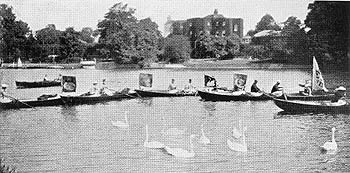 The swans are 'rounded up'...
The swans are 'rounded up'...
In the above picture the flag flying on
the right hand boat features an 'E' and 'VII' so this picture
was taken during the reign of Edward VII [1901-1910]. The king's
Swan Master would travel in this boat. These pictures date from
around 1908 as the picture below also features the Thames Hotel,
extreme right, which was constructed at about that time.
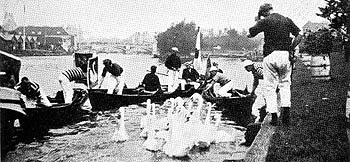 ...so that the swans can be caught...
...so that the swans can be caught...
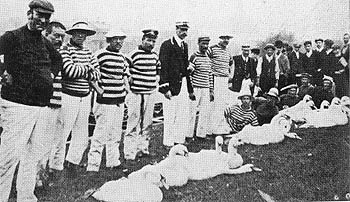 ...ready for ringing.
...ready for ringing.
Monitoring the Swans Welfare
 Swans at Windsor Reach - July 2000
Swans at Windsor Reach - July 2000
The Queen's Swan Marker produces a report
at the completion of Swan Upping each year, which provides data
on the number of swans accounted for, including broods and cygnets.
The cygnets are weighed and measured to obtain estimates of growth
rates, and the birds are examined for any sign of injury (commonly
caused by fishing hooks and line). The cygnets are ringed with
individual identification numbers by The Queen's Swan Warden,
whose role is scientific and non-ceremonial.
Apart from Swan Upping, The Queen's Swan
Marker has other duties: he advises local organisations throughout
the country on swan welfare and incidents involving swans, he
monitors the health of local swan populations, and he briefs
fishing and boating organisations on how to work with existing
wildlife and maintain existing natural habitats. He works closely
with swan rescue organisations and carries out the rescue of
sick and injured swans when relevant, and coordinates the removal
of swans from stretches of the river Thames used for summer rowing
regattas.
The
following Press Release
was issued in 2002 and is included here for reference
Swan Upping, the annual census of the swan
population on certain stretches of the River Thames, was announced
today by David Barber, The Queen's Swan Marker.
The ceremony of Swan Upping dates from the twelfth century and
takes place during the third week of July each year. It
has always been the duty of the Sovereign's Swan Marker to count
the young cygnets each year and to ensure that the swan population
is maintained. With the assistance of the Swan Warden,
Professor Christopher Perrins of the University of Oxford, the
swans are also given a health check.
Announcing the dates for Swan Upping, David Barber said:
"There has been a significant increase
in the number of breeding pairs nesting this year, with cygnets
hatching earlier than usual. Fortunately the swans have
avoided the spring floods that have washed away many nests in
previous years.
Vandalism has once again taken its toll on the swan
population as nests have been destroyed and eggs broken.
These incidents occur mainly where the swans have nested in unsuitable
locations within easy reach of riverside towns.
Fishing hooks and line are a significant factor in
the injuries and deaths of many young cygnets. Discarded fishing
tackle poses a severe threat of drowning and ingested hooks and
line cause immense suffering which often results in death.
The dedication and vigilance shown by swan rescue
organisations, combined with the support of the public and the
work of the Environment Agency, is helping to maintain swan numbers.
Conservation continues to play a vital role in the
ceremony of Swan Upping. It collates important data that
reflects the enormous changes in the river's environment over
past years, and a greater awareness of methods of conservation
has resulted in a higher level of protection for the swans.
Education will play an important role in Royal Swan
Upping this year and several schools will be visiting the banks
of the River Thames. This educational programme will give young
children an insight into how to protect the welfare of the swans.
Children from local schools will accompany the Swan
Uppers as they carry out the swan census and health checks.
They will have the opportunity to learn the history of Swan Upping
and to understand the conservational impact of the ceremony today.
I hope this will increase their awareness of the
value of our wildlife and import a sense of the respect with
which it should be treated."
Local schools seeking further information
should contact the Swan Marker's office on 01628-523030.
|
[Return to top of page]
A Typical Timetable
for Swan Upping on the Thames.
This normally takes place during the third week of July .
| Monday
Sunbury Lock |
09.00 (Departure point) |
| Shepperton Lock |
10.45 |
| Penton Hook Lock |
12.30 |
| Romney Lock |
17.30 |
| Tuesday Eton College Boat House |
09.00 (Departure point) |
| Boveney Lock |
10.15 |
| Boulters Lock |
13.30 |
| Marlow Lock |
17.45 |
| Wednesday Marlow Bridge |
09.15 (Departure point) |
| Hurley Lock |
10.30 |
| Hambleden Lock |
11.45 |
| Henley Town |
13.30 |
| Marsh Lock |
16.30 |
| Thursday Sonning-on-Thames |
09.00 (Departure point) |
| Caversham Lock |
10.30 |
| Mapledurham Lock |
12.45 |
| Goring Lock |
17.30 |
| Friday
Moulsford |
09.00 (Departure point) |
| Benson Lock |
10.15 |
| Culham
Lock |
16.00 |
| Abingdon Bridge |
17.15 |
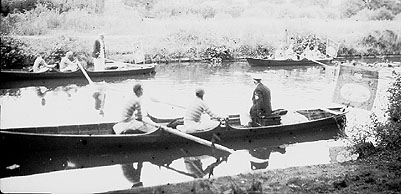 1940s. Part of the flotilla rows
upstream from Romney Lock
1940s. Part of the flotilla rows
upstream from Romney Lock
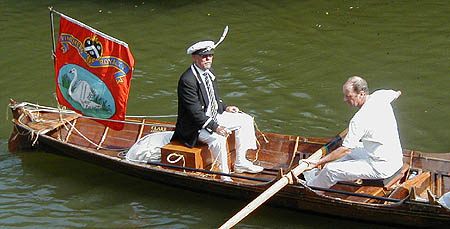 The Vintners Company skiff. July
2000. Note the Swan feather in the cox's cap!
The Vintners Company skiff. July
2000. Note the Swan feather in the cox's cap!
Swan Upping July 2000 In Pictures
Swan
Upping History
News
of The Regal Swan Project, Florida, USA
News
Stories Home Page
River Thames Home Page
Royal
Windsor Home Page

To contact
us, email Thamesweb.
|









